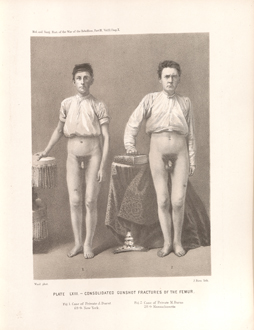Title: Durst, J.
Source text: The Medical and Surgical History of the War of the Rebellion. (1861-65.), Part 3, Volume 2 (Washington, DC: Government Printing Office, 1883), 194-196.
Civil War Washington ID: med.d2e9321
TEI/XML: med.d2e9321.xml
CASE 398.—Private J. Durst, Co. D, 69th New York, aged 21 years, was wounded at Hatcher's Run, March 25, 1865. On the following day he was admitted to the Depot Hospital of the Second Corps, at City Point, and, on March 30th, he reached Washington, where he entered Armory Square Hospital. Acting Assistant Surgeon G. K. Smith contributed the following history: "A minié ball entered the anterior aspect of the right thigh at the junction of the middle and lower thirds, passing backward and fracturing the femur, and made its exit opposite the wound of entrance. The injury produced very little constitutional disturbance, and the discharge from the wound did not exceed two drachms in twenty-four hours at any time. The limb was treated in Hodgen's splint, without extension, until April 14th, when it was placed on a mattress with a sand bag on each side to keep it in position, and extension was applied by Buck's method. On June 9th the extension was removed and the bone was found to be firmly united, with one and one-fourth inches shortening. The patient was now walking on crutches. The anterior wound had healed for about a week, but the posterior wound was still discharging very slightly. By June 23d he had good movement of the knee and could bend the leg to a right angle with the direction of the thigh. The discharge from the wound at this time did not amount to over one drachm in a week. No fragments of bone were ever removed, and the limb healed almost as kindly as a simple fracture, showing no deformity except the shortening." The patient was subsequently transferred to DeCamp Hospital, David's Island, New York, and, on August 19, 1865, he was discharged and pensioned. Examiner W. M. Chamberlain, on August 22, 1866, certified to a "well united fracture of the right femur, with only one inch shortening, and some lameness and debility of the limb." Substantially the same was reported at subsequent examinations until January 19, 1876, when the New York Board certified to the injured thigh being as well nourished as the other, and to the disability as having ceased, in accordance with which the pensioner was dropped from the Pension Rolls. A photograph of the patient, taken at the Army Medical Museum in June, 1865 (Surg. Phot. Series, No. 46, A. M. M.), is represented in PLATE LXIII, opp. p. 196.
